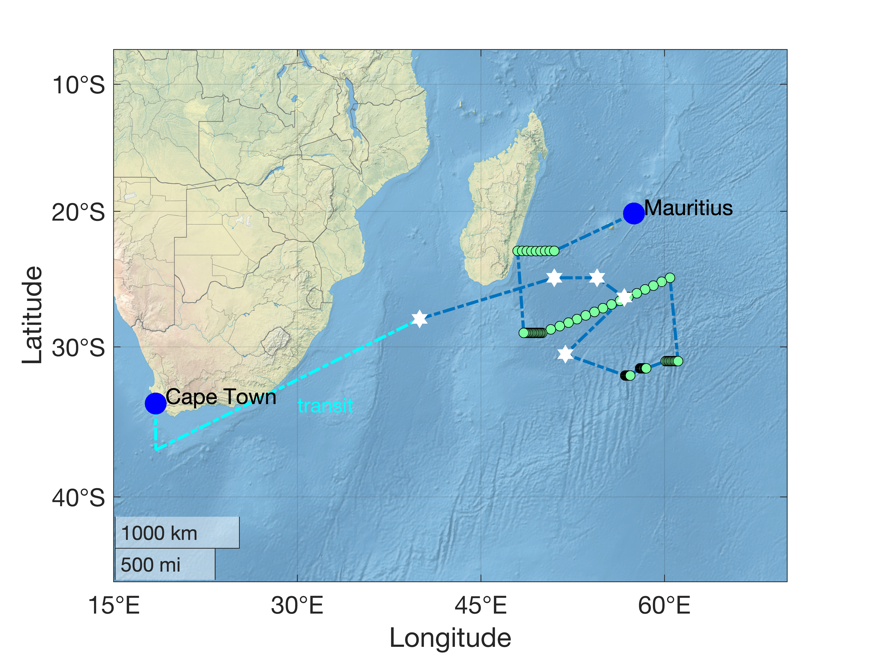[IIOE2-EP50] EMC Experiment: Examining the Fate of the East Madagascar Current
Lead Investigator :
- Viviane Menezes,Woods Hole Oceanographic Institution, USA
vmenezes[at]whoi[dot]edu
Other Key participants (s):
- Heather Furey,Woods Hole Oceanographic Institution, USA
hfurey[at]whoi[dot]edu - Juliano Ramanantsoa,Norce Norwegian Research Centre, Norway
hram[at]norceresearch[dot]no - Amy Bower,Woods Hole Oceanographic Institution, USA
abower[at]whoi[dot]edu
Period of Project: 1 October 2021 - 30 September 2025
Brief description of the Project:
The system of ocean currents that forms the global Meridional overturning circulation (GMOC) plays a central role in regulating Earth's climate. One of the least understood yet critical aspects of this system is the upper-layer circulation near the southern tip of Madagascar in the South Indian Ocean. The southward-flowing East Madagascar Current (EMC) -- a conduit for warm and fresh Indonesian Throughflow (ITF) Water to the subtropical South Indian Ocean and beyond-- is in many ways a typical western boundary current, except that it 'runs out' of the boundary at relatively low latitude (25.5°S). What happens when this vigorous current detaches from the southern tip of Madagascar is still a mystery, debated in the literature since the 1970s. Some argue that the EMC breaks up into mesoscale eddies which travel west and join the Agulhas Current, whose pinched-off rings and filaments drift into the Atlantic Ocean; others that the EMC retroflects eastward to the South Indian Countercurrent (SICC), which flows to Australia; while others contend that both pathways exist, but the retroflection is restricted to the surface layer. It has also been hypothesized that a full or partial retroflection of the EMC is a nutrient source to the yet unexplained Southeast Madagascar Bloom-- a global 'hotspot' for primary production in an otherwise oligotrophic subtropical region. There is a dearth of in situ observations in the detached EMC. To solve this problem, the EMC experiment will simultaneously release surface drifters and subsurface isopycnal RAFOS floats at the thermocline depths. These pairs of drifters and floats will be released in the EMC four times over a year. This Lagrangian experiment, the first of its kind in the EMC, will be paired with particle tracking simulations to investigate surface and subsurface pathways associated with the detached EMC, its connectivity with the Agulhas Current and the SICC, and respective transit times. Our research will assess the impacts of EMC strength, downstream propagating eddies, and seafloor topography on the detached EMC pathways. This knowledge is crucial to understanding the ITF water journey within the South Indian Ocean, the Southeast Madagascar Bloom development, southern Madagascar coastal upwelling cells, as well as impacts on the Agulhas Current and the GMOC. The proposed research is a US contribution to the 2nd International Indian Ocean Expedition.
Region of study:
Our study region is the Madagascar basin in the Southwest Indian Ocean. Our main field experiment will happen from April 4 to May 15, 2023, on board R/V Revelle (20S-35S, 30E-65E). The fieldwork will consist of deployment source sources (stars in the maps), RAFOS floats, and drifter deployments. Besides that, we will collect shipboard ADCP, temperature, salinity, oxygen, nutrients, CFC/SF6 tracers, and LADCP from the sea surface to the bottom. We will depart from Cape Town, South Africa, and arrive in Port Louis, Mauritius. We welcome IIOE-2 colleagues and students to piggyback on our field experiment.
In addition to the leading cruise, a secondary cruise on board a sailing vessel will be done late in 2023 for additional float and drifter deployments near Madagascar.
EMC/DMB Cruise on board R/V Revelle 2023: Stations are green dots, and stars are sound sources. The positions of both are being revised.


